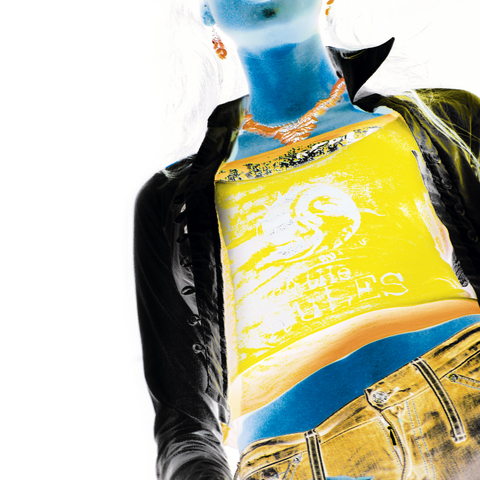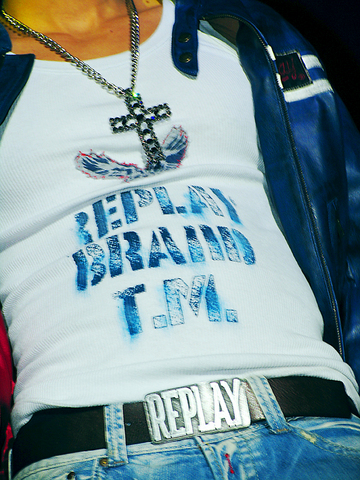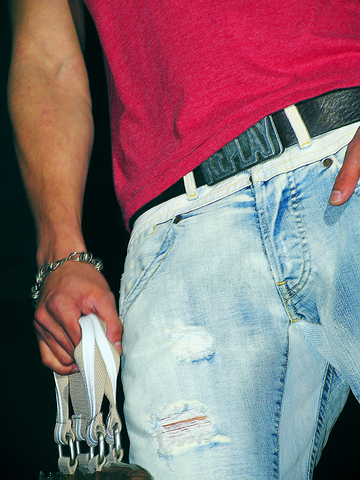Italian design company Replay put on a show last week that once again reminded us there's nothing new in fashion, just variations on the same theme that are recycled from one collection to another.
As you would expect from a maker of jeans, denim was everything and innovation was in the details. There were bright flourishes of yellow, pink and red for the zippers on jean pockets, logos on trouser flies and rivets and buttons in unusual places.
It was classic streetwear with a twist. The jeans were uniformly distressed, ripped and patched, with reinforced stitching that brightened and complemented the overall look of faded elegance. Tops were predominantly cotton and reprised themes that have made a splash in previous collections.

There were few surprises and this should have been expected. After all, Claudio Buziol called his company Replay because it seemed to him that his shirt designs in the late 1970s were repeating the past. He was watching a soccer game at the time he realized this and there was a "Replay" sign on the screen, hence the name.
Since this time Replay has gone on to become a presence on the high street, first in Europe and since then around the world. Replay is now one of four brands (along with Replay and Sons, E-Play and Coca-Cola Jeanswear) that are part of the Fashion Box Group, with sales exceeding 215 million euros (US$276 million), in over 50 nations, through more than 4,000 sales outlets.
As for the company's most recent show, held at 18 and 18 for Lovers in the Warner Village zone, there were some "ooohs" and "aaaaahs" from the assembled crowd of clubbers, but these were mostly elicited by the exposed midriffs and butt cheeks of the models.

T-shirts may have proclaimed "Break the Rules," but the feel was retro.
Men's shirts often played on the Hawaiian theme, with fronds and tropical flowers in washed-out colors. A faded blue and yellow plaid short-sleeved shirt was decorated with palm trees and an orange Replay logo. Some shirts wrapped around the body rather than simply buttoning down the middle and exposed ripped abdomens. A classic white dress shirt brightened up by silvery sequins caught the eye.
Another look was Harley Davidson biker-meets-Italian-fashionista, with a blue leather jacket, big belt buckle, spray-painted "Replay Brand T.M." T-shirt, set off with a diamante cross. A Mandarin-style denim jacket had both buttons and a zip and an off-white strip down the front.

As for the ladies, the dominant impression was of a succession of artfully ripped jeans, revealing miniskirts and hotpants, as well as cotton tops. Sometimes these were combined, as with the dress worn over jeans that had a gorgeous lilly and palm pattern. Made from cotton, denim and hemmed with ivory lace, it made a strong impression.
Cotton T-shirts of US vintage design had screen-print style flower motifs and slogans like "Emotional Life" in pink over black. Denim skirts also had printed designs. There were layered patches, brass rivets in unusual places and heavy stitching around the pockets. The best feature, however, was the tailored patches in various colors that were made into pockets or were added purely for effect. Large denim pockets dangling from a belt on a tiny pair of hotpants were a successful design innovation.
Overall, this was fashion for the street and beach tailored to the masses. There were no shocks but if it's casual wear with a twist that you want, check out your nearest Replay store, either at Idee on Zhongshan North Road (near the MRT) or New York, New York in Warner Village, Xinyi district.


In recent weeks the Trump Administration has been demanding that Taiwan transfer half of its chip manufacturing to the US. In an interview with NewsNation, US Secretary of Commerce Howard Lutnick said that the US would need 50 percent of domestic chip production to protect Taiwan. He stated, discussing Taiwan’s chip production: “My argument to them was, well, if you have 95 percent, how am I gonna get it to protect you? You’re going to put it on a plane? You’re going to put it on a boat?” The stench of the Trump Administration’s mafia-style notions of “protection” was strong

Every now and then, it’s nice to just point somewhere on a map and head out with no plan. In Taiwan, where convenience reigns, food options are plentiful and people are generally friendly and helpful, this type of trip is that much easier to pull off. One day last November, a spur-of-the-moment day hike in the hills of Chiayi County turned into a surprisingly memorable experience that impressed on me once again how fortunate we all are to call this island home. The scenery I walked through that day — a mix of forest and farms reaching up into the clouds

With one week left until election day, the drama is high in the race for the Chinese Nationalist Party (KMT) chair. The race is still potentially wide open between the three frontrunners. The most accurate poll is done by Apollo Survey & Research Co (艾普羅民調公司), which was conducted a week and a half ago with two-thirds of the respondents party members, who are the only ones eligible to vote. For details on the candidates, check the Oct. 4 edition of this column, “A look at the KMT chair candidates” on page 12. The popular frontrunner was 56-year-old Cheng Li-wun (鄭麗文)

Oct. 13 to Oct. 19 When ordered to resign from her teaching position in June 1928 due to her husband’s anti-colonial activities, Lin Shih-hao (林氏好) refused to back down. The next day, she still showed up at Tainan Second Preschool, where she was warned that she would be fired if she didn’t comply. Lin continued to ignore the orders and was eventually let go without severance — even losing her pay for that month. Rather than despairing, she found a non-government job and even joined her husband Lu Ping-ting’s (盧丙丁) non-violent resistance and labor rights movements. When the government’s 1931 crackdown